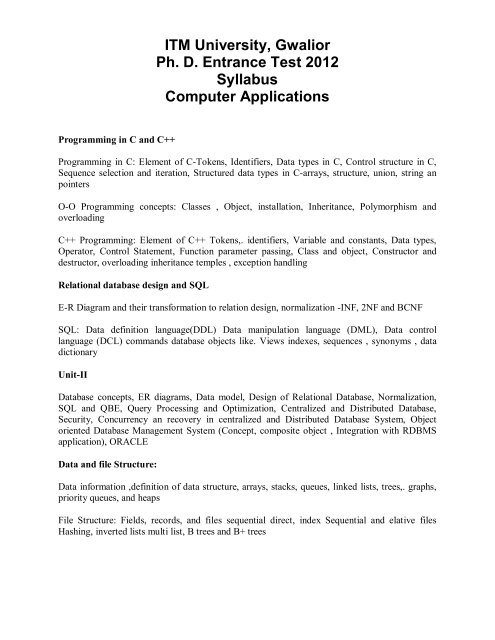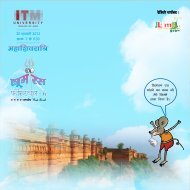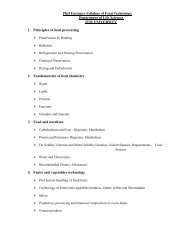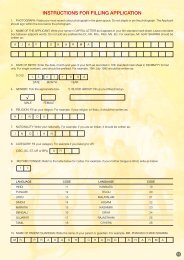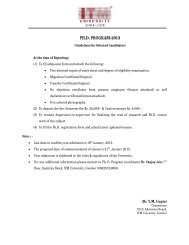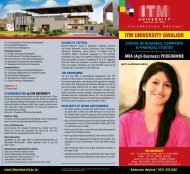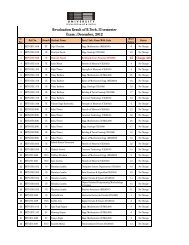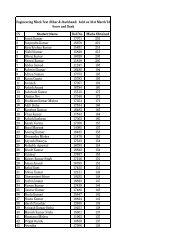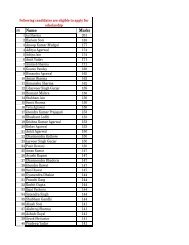Computer Applications - ITM University
Computer Applications - ITM University
Computer Applications - ITM University
You also want an ePaper? Increase the reach of your titles
YUMPU automatically turns print PDFs into web optimized ePapers that Google loves.
<strong>ITM</strong> <strong>University</strong>, Gwalior<br />
Ph. D. Entrance Test 2012<br />
Syllabus<br />
<strong>Computer</strong> <strong>Applications</strong><br />
Programming in C and C++<br />
Programming in C: Element of C-Tokens, Identifiers, Data types in C, Control structure in C,<br />
Sequence selection and iteration, Structured data types in C-arrays, structure, union, string an<br />
pointers<br />
O-O Programming concepts: Classes , Object, installation, Inheritance, Polymorphism and<br />
overloading<br />
C++ Programming: Element of C++ Tokens,. identifiers, Variable and constants, Data types,<br />
Operator, Control Statement, Function parameter passing, Class and object, Constructor and<br />
destructor, overloading inheritance temples , exception handling<br />
Relational database design and SQL<br />
E-R Diagram and their transformation to relation design, normalization -INF, 2NF and BCNF<br />
SQL: Data definition language(DDL) Data manipulation language (DML), Data control<br />
language (DCL) commands database objects like. Views indexes, sequences , synonyms , data<br />
dictionary<br />
Unit-II<br />
Database concepts, ER diagrams, Data model, Design of Relational Database, Normalization,<br />
SQL and QBE, Query Processing and Optimization, Centralized and Distributed Database,<br />
Security, Concurrency an recovery in centralized and Distributed Database System, Object<br />
oriented Database Management System (Concept, composite object , Integration with RDBMS<br />
application), ORACLE<br />
Data and file Structure:<br />
Data information ,definition of data structure, arrays, stacks, queues, linked lists, trees,. graphs,<br />
priority queues, and heaps<br />
File Structure: Fields, records, and files sequential direct, index Sequential and elative files<br />
Hashing, inverted lists multi list, B trees and B+ trees
<strong>Computer</strong> Network<br />
Network Fundaments: Local area Network (LAN), metropolitan Area Network *(MKAN), Wide<br />
area Network (WAN)m, Wireless Network , Inter Network<br />
Reference Model: The OSI model , TCP/IP model<br />
Data Communication: cannel capacity. Transmission media. Twisted pasi Coaxial cables, Fiber<br />
optic cables, Wireless transmission -radio, microwave infrared and millimeter waves Light wave<br />
transmission , telephones-local loop, trunks, multiplexing switching, narrowband ISDNm<br />
broadband ISDNm ATM, High speed LANS, Cellular radio Communication satellite-<br />
Geosynchronous and low orbit<br />
Internetworking: Switch/Hub . Bridge, router, Gateways Concatahetsd virtual circuits,<br />
Tunneling, Fragmentation Firewalls<br />
Routing: Virtual circuits and datagram’s, Routing algorithms , congestion control<br />
Network Security: Cryptography-Public key, Secret Key, domain Name System (DNS),<br />
electronics mail and worldwide web (WWW), the DNs Resource Records Name Services, E-<br />
Mail Architecture and Servers<br />
System Software<br />
Assemble language fundamental (8085 based assembly language programming), Assember-2<br />
pass and single pass, Macros and Microprocessor<br />
Loading , linking, program recordable, linkage editing<br />
text editor programming environments debugger and program generator<br />
Compilation and interpretation, Bootstrap compiler. Phase of Compilation process, Lexical<br />
analysis, Lex package on UNIX System<br />
context free grammar, Parsing and parse trees, representation pf parse (derivation) trees as<br />
nightmare and leftmost derivation , Bottom up parsers=-Shift reduce, operator, precedence, and<br />
LR . YACC package an on UNIX system<br />
Top down parses-Left recursion and its removal , recursive descend pares. Predictive parses,<br />
Intermediate codes, Quadruples, Triples, Intermediate code generation , Code generation, Code<br />
optimization<br />
Operating System(with Case study of UNIX)<br />
Main function of operating system, Multiprogramming multiprocessing and multitasking<br />
Memory management: Virtual memory, Paging, fragmentation<br />
Concurrent processing: mutual exclusion, critical regions, locks ad unlock
Scheduling: CPU Scheduling. I/o Scheduling, resource scheduling, Banker’s Algorithm for<br />
deadlock handling<br />
UNIX<br />
the Unix system: File system,. process management, bourne shell shell variables, command line<br />
programming<br />
Filters and commands: Pr, Head , tail, cut paste. siort, uniq, tr, join, etc…Grep, egrep, fgrep etc,<br />
sed, awk, etc.<br />
System calls (like): create, open, close, read, write, seem link, unlink, stat, fstat, unmask, chmos,<br />
exec, fork<br />
Software engineering<br />
System development cycle(SDCL) : Steps, water fall model, Prototypes, Spiral model<br />
Software Metrics : Software Project Management<br />
Software Design : System Design , Detailed design., function oriented design, Object oriented<br />
design, user interface design, Design level metrics<br />
Coding and testing : testing level metrics, Software quality ad reliability, clean room approach,<br />
Software reengineering<br />
Data Ware housing and Mining : Data Ware housing environments, Architecture of a data<br />
warehouses methodology, Analysis design, Construction and administration<br />
Extraction models and pattern form large database , data miming techniques , classification<br />
regression, clustering summarization, dependency modeling, link analysis, sequencing analysis,<br />
mining scientific and business data<br />
<strong>Computer</strong> Architecture:<br />
Combinational circuit design, Sequential Circuit design, Hardware ad Micro programmed<br />
processor design, Instruction formats, Addressing models Memory types and organization,<br />
Interfacing peripheral devices, Interrupts<br />
Microprocessor architecture, Instruction set and Programming (8085. P-III/P-IV),<br />
Microprocessor applications<br />
<strong>Computer</strong> Graphics :<br />
Display system , input devise, 2D, geometry, Graphics operation, 3D Graphics, Animation<br />
Graphic Standard, Application<br />
Concepts, Storage Devices, Input Tools, Authoring Tools, Application files.
Principles of Programming:<br />
Programming language , concepts, Paradigm and models<br />
Data , Data types, Operators, Expressions, Assignments , Flow of control-Control Structure, I/O<br />
Statement, User Defined and Built in Function parameter passing<br />
Principles , Classes, Inheritance, Class hierarchies, Polymorphism, Dynamic binding, reference<br />
semantics and their implementation<br />
Principles, functions, lists, types and polymorphism, higher order functions lazy evaluation<br />
equations and pattern matching<br />
Principles , horn clauses and their execution, logical variables relations, data structure,<br />
Controlling the search order, programme development in prolog implementation of prolog,<br />
example programme in prolog<br />
Principle of parallelism co routines, Communication and execution, Parallel virtual Machine<br />
(PVM) and message passing interface (MPI), routine an calls , Parallel programmes in PVM<br />
paradigm a swell as MPI, paradigm for simple problems like matrix multiplication<br />
Preconditions , post conditions, axiomatic approaches for semantic, correction’s denotation<br />
semantics<br />
Complier structure, Compiler construction tools, coalition phases<br />
Finite Automata, Pushdown Automata, Non-Determinations, and NFA, DPDA and PDAs and<br />
language accepted by these structure, Grammars, language-Types of grammar-type,0, type 1,<br />
tope 2, type 3, The relationship between types of grammars, and finite machine, Pushdown<br />
automata and context free Framers, Lexical Analysis-regular express and regular languages.LEX<br />
pacemaker on UNIX, Conversion of NFA to DFA minimizing the number of states in a DFA,<br />
Compilation an interpretation Bootstrap Compilers<br />
Context free grammars, Parsing and parse trees, representation of parse trees as rightmost ma<br />
leftmost derivation. Bottom up parsers-shift reduce, operator precedence an LR, YACC package<br />
on UNIX, system, Top down parsers-Left recursion and its removal , recursive descent Parsers,<br />
Predictive parser Intermediate codes-Quadruples, triples, Intermediate code generation, Code<br />
generation , Code optimization<br />
Algorithm Design:<br />
Definition , simple and composite structure, Arraue lists, stacks queues, Priority Queues, Binary<br />
trees , B-Trees Graphs<br />
Sorting searching Algorithms, Analysis of algorithms, Interpolation and Binary search,<br />
Asymmetric notation, Bih ohm, Omega and Theta, Average case case analysis of simple<br />
programmes like finding of maximum of n elements, recursion and its systematic removal,<br />
Quicksort-Non-recurive implementation with minimal stake storage, Design of algorithm(divide
and Conquer, greedy method, Dynamic programming Back tracking, Brach and Bound(), Lower<br />
bound theory, Non-deterministic algorithm Non-Deterministic algprogramming, construct,<br />
Simple non-deterministic programs, NP-hard and NP-complete problems<br />
Artificial Intelligence :<br />
definition, AI approach foe sloping problems<br />
Automated Reasoning with propositional logic and predicate logic-Fundamental proof<br />
procedure, Refutation , resolution refinement to resolution (ordering/Pruning/Restriction<br />
strategies) heuristic search algorithms.<br />
Components of an expert system, Knowledge representation and acquisition techniques, Building<br />
Error Correcting and detecting Codes: Finite fields, Hamming Distance, Bounds of Codes,<br />
Linear (Party check) Codes, Parity check matrix, generator Matrix, Decoding of linear codes,<br />
Hamming Codes<br />
Image Processing: Image Processing, Spatial Fourier, Transform Discrete Spatial Fourier<br />
Transform Restoration , Loss compression of image s(pictures)<br />
Data compression techniques :representation and compression of text, sound, picture, and video<br />
files based of MPEG and JPEG standards<br />
Neural network: Perception Model, Linear Severability and XOR problem, Two and three<br />
layered neural network, Backprpaogation-Convergence, Hopfield nets, Neural net Learning,<br />
Application<br />
Fuzzy System: Definition of a Fuzzy ste, fuzzy relation, fuzzy functions, Fuzzy measures, Fuzzy<br />
reasoning, Application of Fuzzy systems


